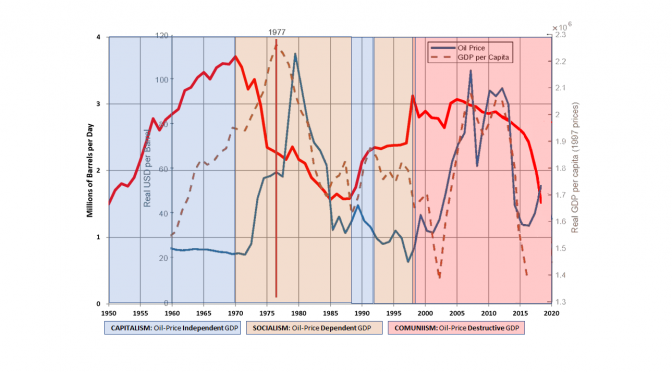“Capitalism is the only system of economics compatible with human dignity, prosperity, and liberty. To the extent we move away from that system, we empower the worst people in society to manage what they do not understand.” — Frederick Hayek
Venezuela epitomizes Hayek’s dictum. It enjoyed the world’s fourth highest per-capita income in 1961, when it established the political system that over the six following decades, it tenaciously expanded, until fully abolishing capitalism and destroying its economy.
Visualizing how the progression from one wealth-extreme to the other happened, entails charting how each of the dominant economic regimes, before and after 1961, impacted Real GDP per capita (dotted line) and oil production (continuous red line), versus Oil price (continuous blue line). Below, a few more pointers:
BACKGROUND COLOR RUBRIC
Blue– Capitalism: GDP and Oil production grow unbounded, despite Oil price
Yellow– Socialism: GDP binds to Oil price and Oil production drops materially
Red– Communism: GDP depends on Oil price and Oil production starts a persistent descent
TIMELINE AND
- The coloring of the labels coincides with the periods along the timeline when Venezuela, formally or not, adopted each type of economic policy. Note that GDP & Oil Production outcomes closely follow the rubric above, even for the shortest time period (89- 92).
- Though in 1961, Venezuela adopted central planning as the guiding principle of its economy, it continued to enjoy the same degree of economic freedom that allowed foreign concessionaires to invest capital, knowledge and technology in developing oil production to the high reached in 1970, when our new constitution began impacting it.
- Though constitutionally allowed since 1961, the nationalization of Venezuela’s oil business was not openly debated in Congress until the late 60s. Yet, by 1970, the certainty that the oil industry would be nationalized had pushed foreign oil companies to stop all new investments in oil exploration and production expansion.
- Even as oil production begins dropping sharply in 1970, GDP doesn’t follow until 1977, a year after oil nationalization. What postponed the decline was the sudden and massive inflow of petrodollars, coming from the multiple oil price increases that began in 1973.
- Capitalism returns in 1989, and though cut short by a military uprising that forces the president to resign, its economic-liberalization and government decentralization reforms go on to benefit Venezuela for at least a decade. Note also that, as per the rubric, GDP & Oil production begin growing, despite oil prices dropping during most of this period.
- Upon the return of Socialism, economic difficulties caused by years of low oil prices and a local banking crisis forced the new president to honor the previous government’s plan to reopen Venezuela’s oil business to foreign oil firms, under the Orinoco Oil Joint Ventures. Once again, Capitalism is what brings oil production back to higher levels.
- Communism begins under a democratically elected militaristic regime, that eventually seizes power via undemocratic maneuvers and starts an indiscriminate wave of company expropriations, FX and economy-wide price controls, and many other counterproductive economic policies that over time bankrupted Venezuela’s economy.
